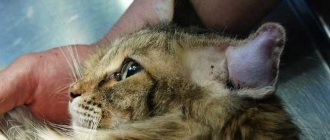Sterilization is unnatural, it is an interference with nature
Housing in itself is a huge interference in the lives of animals. Constant daylight, warmth and regular nourishing feeding lead to the fact that females come into heat more than once a year (classic “March” cats), and sometimes every month. If the cat is not bred, sexual hunting continues all the time, which leads to serious health problems.
And even if you let her give birth to kittens, in nature they are not taken away ahead of time. At home, in the worst case, the babies will end up in a bucket/trash immediately, in the best case, at 1.5-2 months they are already distributed into good hands. And the cat begins to “walk” again.
In nature, animals do not live longer than 4-7 years. And in the case of domestic cats, the owner can expect that his pet will stay with him for at least 15 years, or even more. At the same time, he will treat her for fleas and ticks (and this is also an intervention in nature!), vaccinate her and, if necessary, take her to a veterinarian.
Postoperative period
The first hours after sterilization surgery are especially important. The clinic does not always bring the cat out of the state of anesthesia; often the animal wakes up at home. It should be carried in a special bag, having previously laid an oilcloth on the bottom. In the carrier, the cat should lie on its right side, covered with a diaper on top.
Being in a state of anesthesia leads to a slowdown in the cat's respiratory process, the pulse rate decreases, as does the body temperature. In such a situation, cold is contraindicated for the animal. Therefore, when transporting from the clinic, you can apply a heating pad or a container of warm water to your back, but in such a way that they do not touch the surgical suture. Otherwise, bleeding may begin.
At home, the animal should not be immediately removed from the carrier, but only if the carrier is large. Otherwise, the cat must be placed on an oilcloth laid on the floor.
After sterilization, a cat can sleep for 3-8 hours. It must be taken into account that in a state of narcotic sleep the animal does not close its eyes. To prevent the corneas from drying out, you need to close his eyelids once every 30 minutes. You can use special eye drops that moisturize the mucous membrane.
Sterilization is only necessary for cats that walk outside.
It is a mistake to think that sterilization of cats is necessary only to prevent unwanted kittens from being born. Although limiting reproduction is of great importance, what will be much more important for owners is the fact that sterilization has a positive effect on the health of their pet. Pregnancy and childbirth are a serious burden on the body, as well as constant binge drinking.
The unstable hormonal background of an uncastrated animal leads to the appearance of inflammatory diseases of the uterus, ovaries, and, over time, to oncology of the mammary glands. The unsatisfied need for mating leads to aggressive behavior, marking of territory, and physical exhaustion.
FAQ
Whatever sterilization method you choose, this operation is quite complex and requires a responsible approach. That is why the owners of purrs are tormented by dozens of questions. I will try to answer the most common ones.
Can a cat be spayed while in heat?
Strongly not recommended . It is advisable to wait for this period and go to the veterinarian when the animal’s hormonal levels stabilize. A rush of blood to the genitals may pose a risk of complications during surgery.
How is a cat sterilized?
Sterilization of animals is carried out in several stages:
- examination of the purr;
- administration of drugs to facilitate surgery;
- administration of anesthesia;
- removing hair from an area of skin;
- cutting the skin;
- removal of reproductive organs;
- suturing.
How long does it take to sterilize cats?
The operation itself lasts no more than 20 minutes. However, a preliminary examination and recovery from anesthesia slightly delays the process. So be prepared for your cat to spend about an hour in the veterinarian's office.
Should a cat be allowed to give birth before being spayed?
No, all modern veterinarians recommend sterilizing the animal before the first birth.
Is it possible to sterilize a pregnant cat?
In no case. A possible pregnancy should be excluded before surgery first.
Should an adult cat be spayed?
Only if you consider it necessary. In any case, with age, the animal’s hormonal background and its instincts weaken. So there is no particular need for surgery.
Moreover, many veterinarians do not recommend spaying purrs older than 10 years. At this age, a cat’s body can endure surgery and recovery quite hard.
Do I need to get vaccinations before sterilization?
To avoid infection, the animal should be vaccinated at least 4 weeks before surgery.
The operation is painful for the cat, it is better to avoid such suffering
On the part of owners, the most common argument against sterilization is that the cat is simply “sorry.” Moreover, unlike cats, in cats this is an abdominal operation. It is completely natural to be afraid of surgery. But this fear should force you to more carefully choose a clinic and a doctor for the procedure, and not refuse it altogether.
During the operation, the cat is under general anesthesia (often combined with epidural anesthesia) and feels absolutely no pain. The incision itself (and the suture) is so tiny that already on the second day the pet leads a normal lifestyle - eats, drinks, plays.
Although discomfort during the healing period is indeed possible, it cannot be called suffering, since the cat feels much worse during estrus. Most of the problems are not related to the operation itself, but to wearing a post-operative blanket - cats hate clothes.
Arguments against sterilization
Veterinarians believe that the disadvantages of sterilization are much smaller than the advantages. But in percentage terms they are insignificant. This procedure today is considered quite common, simple and humane.
However, we note that sterilization has some risks:
- Anesthesia . During the operation, general anesthesia is used, which in itself is a certain risk. Therefore, the operation should only be performed in a clinical setting by an experienced doctor. A correctly selected dosage of anesthesia will not entail any negative consequences.
- Complications in the postoperative period . Sterilization is a surgical procedure that leaves a wound and a suture. If not handled correctly, seams can become inflamed. Such cases are very rare.
Neutered cats live shorter lives
Statistics are a stubborn thing. According to numerous studies, sterilized cats live 1.5-2 times longer than their uncastrated counterparts! This is due to a combination of factors. Neutered cats have less contact with their relatives, are less likely to get into fights, and do not try to run away from home (fall out of a window, die in the teeth of a dog, get hit by a car). They do not suffer from numerous gynecological diseases: postpartum endometritis, pyometra, ovarian cyst. They do not die as a result of difficult childbirth or missed abortion. Early sterilization greatly reduces the risk of breast cancer (their tissue remains underdeveloped without exposure to hormones).
It is necessary to allow the cat to give birth once before sterilization.
One of the most persistent myths is that “childbirth is for health.” It happens that when an adult cat of 2-3 years old is brought in for sterilization, the owners complain to the veterinarian about how much trouble the birth and placement of the kittens caused them. To the logical question “why did you give birth?” They blink their eyes in surprise - you have to do it at least once in order to live longer. That's what the breeder said.
In fact, pregnancy and childbirth deplete the female’s body, rather than adding to her health. In addition, late sterilization (after several heats and lactation) no longer prevents the growth of tumors on the mammary glands - a terrible disease to which our four-legged pets are susceptible.
Childbirth is needed for the sole purpose of obtaining offspring, the rest is far-fetched reasons.
After sterilization, the cat becomes fat, lazy, and stops playing.
Partly true. Sex hormones are a powerful fat burner, and during estrus, a cat may refuse food for several days. During pregnancy and lactation, all nutrients are lost to the babies, as a result of which the cat remains thin (sometimes even excessively).
After sterilization, the appetite increases and the need for calories decreases. But fat does not come from thin air! The owner’s task is to reduce the caloric content of the diet by 20-30%. This is usually easily achieved with special diets for sterilized cats, which provide a long-lasting feeling of satiety. And even such food should not be given ad libitum, but according to the norm, depending on the weight and activity of the pet.
In practice, the owners feel sorry for their beloved cat and feel guilty: “food is her last joy in life.” And they slip tidbits from the table. An overweight animal can no longer jump, run or play, becomes passive and gets fatter (a vicious circle). Veterinarians regularly see fat, unspayed animals, as well as slender, neutered cats. Excess weight is not directly related to castration, but depends on nutrition.
The cat may take offense at its owners and become aggressive
A common argument that forces one to refuse surgery: “Doctor, what if she doesn’t forgive me?” Although cats are truly intelligent animals, it would be wrong to anthropomorphize them. Their main difference from us is the ability to live in the present moment; they do not think about the future. In other words, a cat does not dream of giving birth and raising kittens. Therefore, she does not suffer from unrealized maternal instinct.
The trip to the clinic itself and the subsequent inconveniences will be forgotten by the pet as soon as the postoperative blanket is removed. And they will not be connected in any way in the cat’s mind with their beloved owner. More likely with a man in a coat (a veterinarian).
In fact, uncastrated cats and female cats are more likely to show aggression towards their owners: they have more reasons for this. This includes unsatisfied sexual desire, protection of offspring, and the struggle for dominance in a closed territory.
Pros and cons of sterilization
Often, cat owners do not want to take their pet for surgery because the animal must “know the happiness of motherhood.” However, cats do not live by feelings, but by instincts.
Therefore, the cat does not experience “happiness” in motherhood. And what kind of happiness can we talk about when kittens are taken from their mother at the age of 2-3 months (after all, the later the babies are given away, the more difficult it is to find good hands for them). So, if you are not considering sterilization because of the moral and ethical aspect, it would still be more ethical to perform the operation.
Of course, in order to make a final decision regarding surgery, it is important to approach this issue from all sides. So, sterilizing a cat - pros and cons - let's look at each aspect separately.
Benefits of sterilization:
- The animal ceases to feel the discomfort that accompanies estrus.
- The risk of diseases of the ovaries and uterus disappears.
- The risk of tumors appearing on the reproductive organs is noticeably reduced.
- You won't have to adopt kittens, which is not so easy to do if the pet doesn't have a breed.
- The cat's behavior and character will noticeably improve. She will stop damaging sofas and armchairs, as well as meowing loudly.
Of course, in order to be prepared for anything, you need to know not only about the advantages, but also about the disadvantages of sterilization :
- Remember that this is a serious operation, after which (if unsuccessful) the purr may experience serious complications. Fortunately, the qualifications of most modern veterinarians allow surgical intervention to be performed without any problems.
- The operation does not last long, but the recovery period may be prolonged. Please note that all this time you will have to be close to your cat, who will be weak and helpless.
Breeding a purebred cat is very profitable, so there is no need to rush into sterilization
Having bought a kitten from a nursery, some people expect to “recoup” the costs by breeding the pet several times. The lack of documents (pedigree) is not an argument, because many people want to take a cheaper purebred kitten.
In practice: mating with a purebred cat costs money, and the result is not guaranteed. Would-be entrepreneurs spend money on emergency caesarean sections in the night, treatment of postpartum endometritis in the case of stillborn kittens, and the fight against mastitis, in which the babies have to be fed instead of the cat.
Kittens need to be vaccinated, and first given anthelmintic - this is also a cost. Rare people agree to buy a kitten that is not vaccinated. If the baby has an umbilical hernia, it will not be possible to place him at full cost. And in principle, the price for kittens from a mother who is not registered in the club and has not received evaluations at exhibitions cannot be high.
In other words, a seemingly profitable event turns into a lot of hassle, and it’s good if the costs at least pay off.
The operation is a mortal risk, it is better to give the cat hormonal drugs
Sterilization and castration are the safest and shortest operations in veterinary medicine. But this myth was not born out of nowhere. High-breed animals, and occasionally mixed breeds, have congenital heart defects, which increase the risk of death from anesthesia. In addition, modern means for anesthesia have recently become available in Russia, but previously there was a risk of simply overdosing on anesthesia - especially if a rural veterinarian injected it “by eye” without weighing the animal.
Modern means of anesthesia (for example, inhalation anesthesia) are so advanced that the risk of using them is minimal. Hormonal drugs that stop estrus have side effects, the most common of which is pyometra, purulent inflammation of the uterus.
The owner does not face the question of whether to ever operate on the animal. The question should be posed this way: should the cat be operated on as planned on a young and healthy cat or for medical reasons when it turns 5-8-12 years old? If a cat breaks a paw, no loving owner will refuse surgery on the pretext of being afraid. If a person has inflamed appendicitis, he will not hesitate to trust the surgeon.
Sterilization should be perceived as a necessity, and in order to minimize operational risks, you need to choose a clinic and doctor in advance, and undergo examinations (for example, cardiac ECHO, blood clotting test).
Treatment
One of the complications after castrating an animal can be severe pain. In this case, the use of analgesics may be necessary. Before using them, consultation with a doctor is required, since drugs intended for humans can be fatal. Painkillers for animals can also be harmful.
The doctor may prescribe antibacterial drugs. Ceftriaxone or Amoxicillin are prescribed for intramuscular administration. Gamavit is used as a general tonic. If necessary, the veterinarian will prescribe hemostatic drugs.
Sterilizing a cat is very expensive
The question of the cost of the operation arises most often when the kitten itself was received for free. Sometimes finances are really limited - for example, among pensioners. Castration of a cat is 2-3 times more expensive than a cat. This is due to the need for consumables (absorbable threads, blankets, etc.) and a more complex surgical technique.
But in fact, many clinics hold promotions for castration and sterilization. The worldwide Spay Day is very famous - on the last Tuesday of February, in many clinics you can sterilize a cat at a minimal price. Often, the clinic can arrange payment in installments, paying the amount over several months. And in general, prices for sterilization remain acceptable: the operation is technically simple and takes little time, doctors are willing to undertake it. The calculation is simple: after successful sterilization of a young animal, the owners will continue to use the clinic’s services.
Sterilization is a once-in-a-lifetime process, but hormonal medications (even the cheapest ones) must be purchased constantly, and then pay exorbitant prices for the operation of a sick cat.










